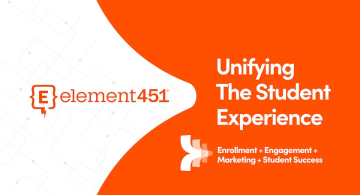6 Ways to Personalize Your Connection With Students
by Sirley Carballo · Dec 08, 2021
If you haven't seen anything about it yet, Apple is making some significant moves in protecting its customer's privacy, and it's going to restrict our ability to email, text, and track prospects.
While this is going to seem like punishment for organizations, we think this is a massive opportunity. It's a chance to rethink how we message prospects, incorporate storytelling into our outreach, and be…human.
We need to change how we do things…just a little.

Reframing how we look at prospects
Unlike our other posts, we're not going to go deep into tools and platforms to help with personalization.
The tips below are about modifying how we treat prospective students as human beings, at the forefront when planning what we say, how we want to say it, and how those messages will go out.
With that said, let's get started.
Know Your Customer
It's elementary to make someone feel special when you know the right things about them, so take the time to get their information. Once you have it, it's just a matter of remembering what's important to them. Include their preferences in every email, in your voicemails-anytime you can. And don't stop there-whenever possible. Go out of your way to do something thoughtful for them.
Studies show that prospects who feel like they know you, like your school, and trust that you understand them are more likely to buy from you. Listen to their concerns and communicate your empathy to them. Make things personal.

Be Human
It all starts with empathy. That's what will set your school apart from the rest. And it begins with a conversation.
Humanizing the brand of your school creates a culture of authenticity. There is no secret strategy to being more human. Be real. Be transparent. Care.
A great example:
The simple magic of a handwritten note. Although this may sound like an outdated approach, it's a breath of fresh air in today's virtual and sometimes impersonal world.
Sending handwritten notes to prospects can significantly impact your follow-up success by increasing the chance that they will accept an offer. It's more personal, thoughtful, and creates rapport with prospects.
Other occasions for penning a heartfelt thank you note include birthdays, special events, successful applications, or even when you want to express your gratitude after someone has given you their time.
As an aside, think how you would feel if, on a day when you've been struggling, someone took the time to send a friendly letter. Game changer, right?
Such a gesture humanizes your outreach and adds a personal touch to your communication.
Tell More Stories
We all want to feel something. We want to be moved by the messages we see.
So, make your prospects feel something. Your future students don't want marketing messages that seem as if machines generated them. They want to be moved. If you can make your audience feel something, you have a much better chance of having them choose your institution.
As best you can, conduct your outreach in a way that doesn't sell to people but tells them a story that inspires them to want to know more about life at your institution.
A great example:
Show us ourselves in others.
While telling the tale of your institution, your campus, and the facilities students will have access to while attending your program is worthwhile. However, telling the story of people, past graduates, and people we can see ourselves in holds much more power.
The story of someone from where we live or who shares a similar background is the start of a tale anyone can relate to and see themselves in.
Isn't that what we all crave, to see the path forward and have some assurance of future success by visiting those who came before us?
That's the kind of storytelling that makes a difference.
Show a Little Empathy
Your school isn't just about your buildings, the campus or even the classes you offer. It's about the people that choose to go there and the educators who give knowledge.
Create meaningful prospect relationships by showing you care with your words. Be empathetic and sincere in every interaction, and they'll feel valued and appreciated.
A great example:
Refrain from making everything transactional.
Sometimes, asking if a prospect needs anything instead of pushing them to take action can be the difference-maker.
Please think of how we interact with the people we care about. Do we regularly blast them with offers and instructions, or do we take an interest in their well-being?
We know that choosing where to go to school is a decision that weighs heavily, and the more we recognize the weight of that decision, the better we'll be.

Stay in Touch
Think of student relationships as long-term commitments. Express gratitude for their time. Ask for feedback. And send them frequent messaging. If you demonstrate you're in it for the long haul, they'll likely reciprocate.
A great example:
We need to look no further than how we're continuing to manage the Covid pandemic for opportunities for staying in touch and communicating more frequently.
It's essential to keep our future students up to date with information, but parents are equally as important when it comes to a health crisis.
Regular updates on containment, testing, and programs for keeping students safe, sent to parents, goes a long way in building the kind of trust required to keep parents comfortable.
Knowing you care can make all the difference when it's come to offer acceptance.
Interact on social media. Don't just publish.
Almost every school uses social media in their outreach (or student research). But how social is your media?
Too many schools use social media as a publishing platform instead of an interactive medium. Take Twitter. How are you using Twitter currently? For publishing 280-character posts four times a week? No. Instead, Twitter should be for favoriting, retweeting, replying, and asking for feedback. Less broadcast, more conversation.
The same goes for all the other big social platforms. If you're going to use social media for its social purposes, start interacting directly with prospects.
A great example:
Promote others before promoting yourself.
For every post you make for your school or program, take 5-10 actions for the people you're hoping to build a connection with.
In the same way, your school will build these young people into their best selves, use your time on social media to cheerlead and make prospects the hero of their journey.
Promote what they do, who they are and the things they put into the world. They'll appreciate the audience and never forget the support.

About Element451
Boost enrollment, improve engagement, and support students with an AI workforce built for higher ed. Element451 makes personalization scalable and success repeatable.
Categories
New Blog Posts

The Definitive Guide
AI in Higher Education
Bridge the gap between the latest tech advancements and your institution's success.
Useful Links
Related Articles

Talk With Us
Element451 is the only AI Workforce Platform for higher education. Our friendly experts are here to help you explore how Element451 can improve outcomes for your school.
Get a Demo









